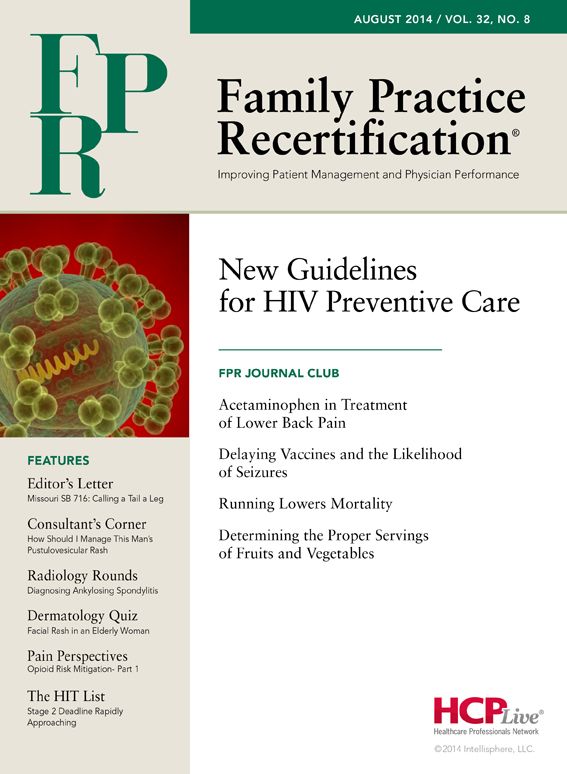Publication
Article
Family Practice Recertification
Opioid Risk Mitigation- Part 1
Author(s):
While opioids represent an important tool in treating pain, it would be foolish to not acknowledge that opioids and opioid prescribing are fraught with potential hazards. However, through the development of a strong risk mitigation platform, primary care physicians can minimize the risks to their patients, as well as to their own practices.

Michael E. Schatman, PhD, CPE
In last month’s Pain Perspectives, I discussed the need to maintain opioid analgesics as an aspect of the primary care pain management armamentarium. While opioids represent an important tool in treating pain, it would be foolish to not acknowledge that opioids and opioid prescribing are fraught with potential hazards. However, through the development of a strong risk mitigation platform, primary care physicians can minimize the risks to their patients, as well as to their own practices.
We are fortunate to have access to a prodigious body of literature that tells us which individuals are at the greatest risk for aberrant opioid-related behavior. These behaviors include, among others, selling prescription drugs, forging prescriptions, stealing drugs, injecting oral formulations, obtaining prescription drugs from non-medical sources, concurrently abusing ETOH or illicit drugs, failing to comply with the prescribed drug regimen despite multiple warnings, and obtaining opioids from medical sources than the original prescriber.1
It is important to understand that even the most rigorous prescreening of patients prior to prescribing is not going to be fool-proof. Yet through due diligence in screening, we can certainly improve the odds toward decreasing aberrancy. Research tells us that the individuals who are at the greatest risk for inappropriate drug-related behavior have various histories including a substance abuse disorder,2-3 a DUI or drug-related arrest,4 cigarette smoking,4 depression,5-6 and anxiety.7
How do we learn whether a certain patient has a history of these risk factors? The key is to take a thorough history prior to prescribing. Once again, the primary care physician is faced with a difficult dilemma: taking a detailed history can be time-consuming, and such a use of time detracts from our abilities to see as many patients as we need to in order to make our practices viable.
However, time spent on the front end of prescribing will likely result in a considerable saving of time down the road. Few would disagree that it requires less time to take a thorough history than it takes to deal with opioid misuse, diversion, overdose, and death. Additionally, taking the time to obtain a thorough history can potentially build trust in a patient’s eyes, as it may be seen as a sign that the primary care physician is interested in his or her well-being.8
Perhaps the greatest downside of taking a history is the possibility that a patient will be untruthful; we have no guarantees of veracity. However, by not asking about risk factors, we are far less likely to learn the truth. A number of physicians have opined that they “just know” which patients are likely to demonstrate aberrancy. This has actually been empirically disproven, with research indicating that by going with one’s “gut reaction,” physicians are likely to be deceived.5
Does the presence of one or more of the empirically-established risk factors preclude opioid prescription? Hardly‑‑having a history that suggests a higher level of risk simply tells us that we need to be more vigilant and cautious in our prescribing practice.
Specific strategies for vigilance and caution will be discussed in great detail in upcoming installments of Pain Perspectives.
References
1) Butler SF, Budman SH, Fernandez K, Jamison RN. Validation of a screener and opioid assessment measure for patients with chronic pain. Pain 2004;112:65-75.
2) Edlund MJ, Sullivan M, Steffick D, et al. Do users of regularly prescribed opioids have higher rates of substance use problems than nonusers? Pain Med. 2007;8:647-656.
3) Morasco BJ, Dobscha SK.Prescription medication misuse and substance use disorder in VA primary care patients with chronic pain.Gen Hosp Psychiatry2008;30:93-99.
4) Ives TJ, Chelminski PR, Hammett-Stabler CA, et al. Predictors of opioid misuse in patients with chronic pain: a prospective cohort study.BMC Health Serv Res. 2006;6:46.
5) Wasan AD, Butler SF, Budman SH, et al. Psychiatric history and psychologic adjustment as risk factors for aberrant drug-related behavior among patients with chronic pain.Clin J Pain 2007;23:307-315.
6) Manchikanti L, Giordano J, Boswell MV, et al. Psychological factors as predictors of opioid abuse and illicit drug use in chronic pain patients. J Opioid Manag. 2007;3:89-100.
7) Sullivan MD, Edlund MJ, Zhang L, et al.Association between mental health disorders, problem drug use, and regular prescription opioid use. Arch Intern Med. 2006;166:2087-2093.
8) Haidet P, Paterniti DA. “Building” a history rather than “taking” one. Arch Intern Med. 2003;163:1134-1140.
About the Author
Michael E. Schatman, PhD, CPE, is a clinical psychologist who has spent the past 27 years working in pain management. He is currently the Executive Director of the Foundation for Ethics in Pain Care in Bellevue, WA, where he also maintains a part-time practice in pain psychology. Schatman is the author of more than 80 peer-reviewed and invited journal articles and book chapters on pain management, and he lectures regularly on both local and national bases.
He is the editor of Ethical Issues in Chronic Pain Management and Chronic Pain Management: Guidelines for Multidisciplinary Program Development, both of which were released in 2007. Currently, he is Editor-in-Chief of the Journal of Pain Research, Ethics Section Head Editor of Pain Medicine and Psychological Injury & Law, and Deputy Editor-in-Chief of the International






